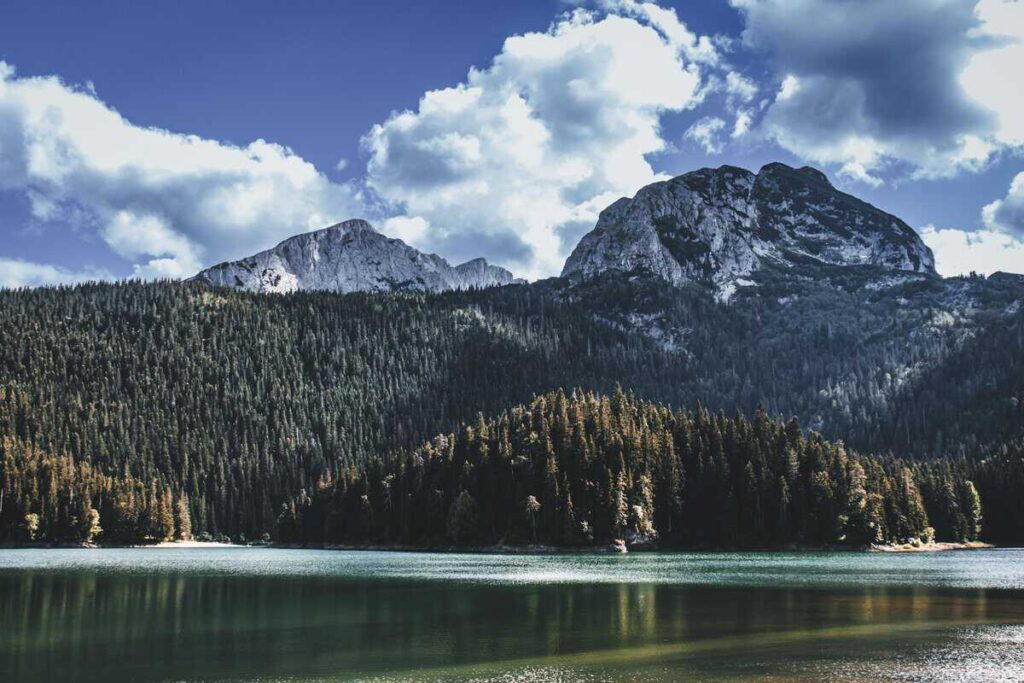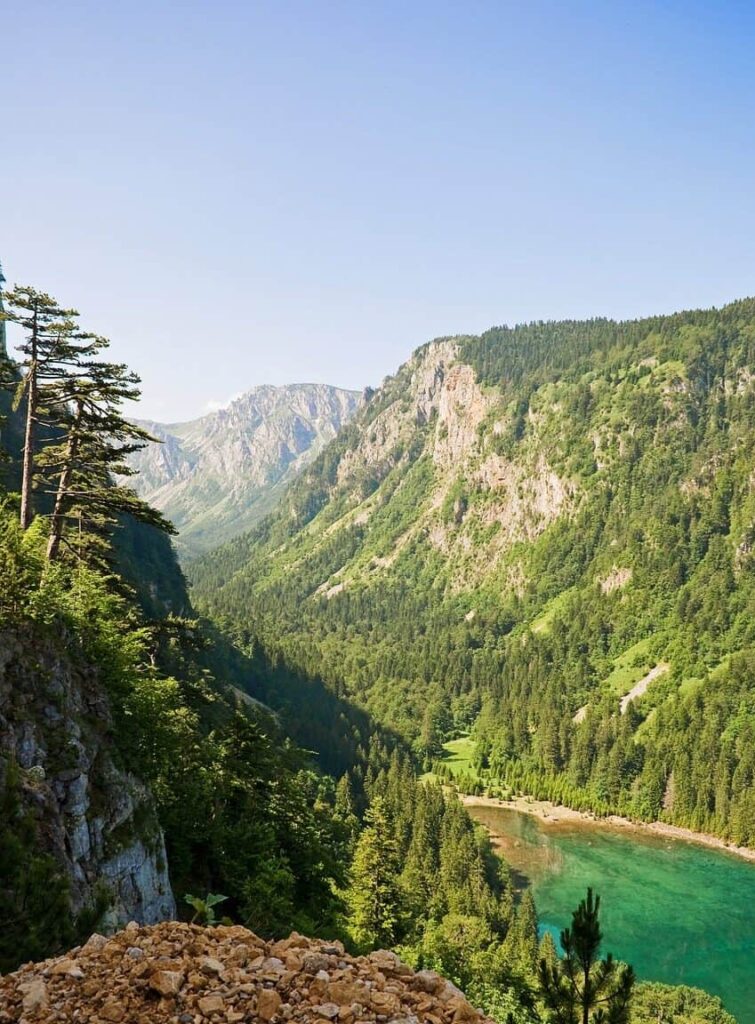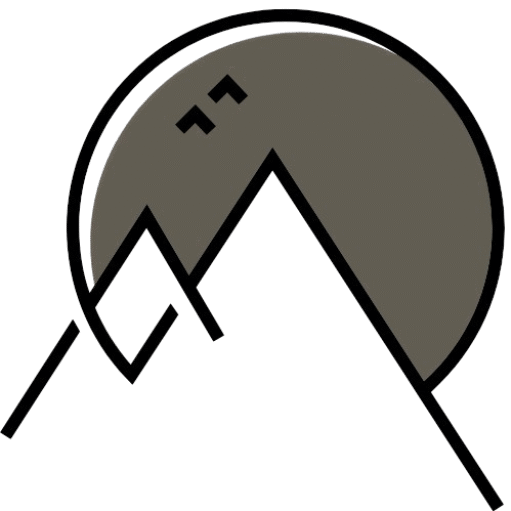Think the Balkans are just sun-soaked beaches? Think again—Durmitor National Park is where Montenegro flexes its alpine muscles — a place of towering peaks, deep canyons, and glacial lakes. A UNESCO World Heritage site, Durmitor is an outdoor playground for hikers, skiers, and adventure seekers. Whether you’re here for the legendary Tara River rafting, the surreal beauty of Black Lake, or just to escape the crowds, this guide will help you plan the perfect trip.
Why Visit Durmitor National Park?
I visited Durmitor National Park as part of a longer trip through Montenegro, and it completely blew me away. What I thought would be a quick stop turned into one of the highlights of my journey. Montenegro’s coast gets all the attention, but its mountains? Seriously underrated.
The landscapes are wild — glacial lakes tucked between jagged peaks, pine forests stretching endlessly, and Tara Canyon, which, fun fact, is the second deepest in the world (after the Grand Canyon, but with way fewer tourists and overpriced souvenir shops). If you like your adventures a little extreme, this place delivers. There’s hiking that will make your legs scream, white-water rafting through canyon rapids, and in winter, skiing in Žabljak, the highest town in the Balkans. But what makes Durmitor special isn’t just the nature—it’s the quiet, the feeling that you’ve stumbled onto something secret. Unlike Montenegro’s coastline, which can feel a bit Instagram-obsessed, Durmitor is unfiltered and real. The small mountain villages are the kind of places where people still wave at strangers, and every meal feels like it was made by someone’s grandmother.

Best Time to Visit
Summer (June–September) | Long days, warm weather, and the best hiking conditions. Yes, it’s peak season.
Autumn (September–November) | Fiery fall colors, crisp air, and fewer tourists—perfect to avoid crowds.
Winter (December–March) | Durmitor’s ski season kicks in, with Žabljak offering affordable skiing and snowboarding.
Spring (April–May) | Snowmelt means waterfalls in full force, and trails start reopening—expect lush greenery.
Best Things to Do in Durmitor National Park
Durmitor National Park isn’t the kind of place where you just drive through, take a few photos, and call it a day. You have to spend more time here! Whether you want to tackle the highest peak, raft through one of the deepest canyons in the world, or just sit by a quiet glacial lake and watch the world slow down – you’ll find something for you. Unless you hate nature, in which case get off my blog!
Hiking & Trekking
Durmitor has no shortage of hiking trails, and while it might not be one of the world’s elite trekking destinations, it still offers rugged, rewarding hikes through dramatic landscapes. In fact, Montenegro’s very name comes from the Venetian Monte Negro, meaning Black Mountain—a fitting tribute to the country’s wild peaks.

Bobotov Kuk (2,523m)
If you only do one hike in Durmitor, make it Bobotov Kuk. Standing at 2,523m (8,278 ft), it’s the highest peak in the park and offers jaw-dropping views of the entire Durmitor massif, stretching out like a sea of jagged limestone waves. The hike up is a solid challenge, with steep, rocky sections and some scrambling required near the summit. It’s the kind of view that makes you forget how exhausted you are—at least for a few minutes.
Difficulty: Hard
Distance: ~10 km round trip
Time: 5-6 hours
Starting point: Sedlo Pass, about a 30-minute drive from Žabljak. The trail is well-marked but steep, so starting early is a good idea to avoid the midday heat.
Crno Jezero (Black Lake)
Black Lake is Durmitor’s most famous and accessible lake. Surrounded by towering pine forests and backed by sharp peaks, it’s an easy and scenic loop perfect for a relaxed morning or afternoon walk. If hiking isn’t on your agenda, grab a coffee from the lakeside café and just take in the view—it’s one of the best in the park.
Difficulty: Easy
Distance: 3.5 km loop
Time: 1-2 hours
Starting point: The lake is just a short walk from Žabljak, making it an ideal spot for anyone staying in town.
Ice Cave (Ledena Pećina)
Hiking to an actual ice cave in the middle of summer! The Ledena Pećina trail leads you to a hidden glacier cave, where frozen stalactites hang year-round. It’s a surreal experience, stepping into the icy air while the sun blazes outside. The hike is a steady uphill climb, but the unique destination makes it worth the effort.
Difficulty: Moderate
Distance: 8 km round trip
Time: 4-5 hours
Starting point: The trail begins near the Katun Lokvice shepherd huts, which can be reached from Black Lake with an additional hike. The path is marked but can be rocky, so good footwear is a must.
Skrka Lakes Valley
If solitude is what you’re after, Skrka Lakes Valley delivers. This remote spot features two stunning alpine lakes, framed by some of Durmitor’s most dramatic peaks. The hike is long but rewarding, making it ideal for those who want a full day of exploring away from the crowds.
Difficulty: Moderate
Distance: ~12 km round trip
Time: 5-6 hours
Starting point: The trail starts from Dobri Do Valley, accessible by car from Žabljak. The route passes through high mountain terrain, so expect some elevation gain and rocky paths.
Durmitor’s Hidden Trails
Want a trail that nobody on Instagram has geotagged yet? With nearly 50 peaks over 2000 meters, and countless trails, Durmitor is full of lesser-known hikes leading to hidden valleys, remote peaks, and secret lakes. Sometimes, the best adventures are the ones you find on your own.

Durmitor Ring Scenic Drive
The Durmitor Ring is a 76 km loop through some of Montenegro’s most remote and dramatic landscapes. It starts and ends in Žabljak, winding through high-altitude passes, deep gorges, and remote villages. The road is mostly paved but narrow and steep in places, making it an adventure in itself. A full loop takes about 4–5 hours without stops, but realistically, you’ll want to take your time because nearly every turn demands a photo.
The best way to tackle the drive is clockwise from Žabljak, passing through Sedlo Pass, the highest paved road in Montenegro. This stretch is stunning—bare rock faces rising like ancient fortresses, with nothing but sky above and twisting asphalt below. As the road descends, the landscape softens into Dobri Do Valley, a wide-open expanse where shepherds tend to flocks like something out of an old Balkan folktale.
One of the most breathtaking stops is Piva Lake, where the water is an almost electric blue, hemmed in by sheer cliffs. If you catch it on a windless day, the reflection of the mountains in the still water makes the world feel doubled. The road skirts the edges of the lake before looping back toward Žabljak, where you can finish off with a well-earned meal at a local konoba (tavern).
Tips for Driving the Durmitor Ring:
- Start early to avoid midday heat and tour groups.
- A regular car is fine, but be ready for some steep, narrow sections with no guardrails.
- No gas stations on the route, so fill up before leaving Žabljak.
- Plan for stops—there are no tourist facilities along the way, just raw, untamed nature.
Tara River Canyon – The World’s Second Deepest Canyon
The Tara River Canyon cuts through Durmitor like a gash in the earth, with limestone cliffs dropping over 1,300 meters to the river below. The Tara River itself shifts between calm, mirror-like stretches and roaring rapids, carving out the second deepest canyon in the world. Whether you’re standing at the edge or flying over it, the scale is almost impossible to process—it makes you feel tiny in the best way possible.
White-Water Rafting on the Tara River
Rafting the Tara River is one of the most thrilling ways to experience the canyon. The river twists through narrow rock corridors, past waterfalls tumbling down sheer cliffs. The rapids are a mix of gentle sections where you can take in the views and fast, turbulent stretches where you’ll get completely soaked. Spring and early summer bring high water levels and stronger rapids, while late summer and autumn offer a more relaxed ride with clearer, calmer water.
Most rafting trips start near Brštanovica and cover 15–25 km of the river, ending near Šćepan Polje at the Montenegrin-Bosnian border. Trips typically take 3–5 hours, depending on water conditions, and nearly every tour includes a lunch stop at a riverside camp—expect hearty mountain food like grilled meats, fresh bread, and local rakija (brandy).
Zip-lining Over the Canyon
If rafting isn’t enough, zip-lining over Tara Canyon will take things up a notch. The Đurđevića Tara Bridge serves as the launch point for several high-speed zip lines that send you soaring 150 meters above the river at 80 km/h. The feeling of launching off the edge is pure adrenaline—the ground vanishes beneath you, and suddenly, you’re flying over a vast chasm of turquoise water and jagged cliffs.
It’s over too fast, but it’s worth every second. If you want the ultimate view, go right before sunset, when the canyon is bathed in golden light.
Savin Kuk Cable Car Ride
For those who want mountain views without committing to a long hike, the Savin Kuk cable car is the easiest way up. The ride takes you nearly 2,000 meters above sea level, offering a sweeping view over Black Lake, Žabljak, and the surrounding peaks. In summer, it’s a great way to get straight to the views without breaking a sweat, while in winter, it’s the heart of Durmitor’s ski scene. (mention the ski)
Visit St. Michael the Archangel Orthodox Monastery
If you need a break from all the adventure, this historic monastery is a peaceful, off-the-beaten-path stop. Built centuries ago, this small Orthodox monastery sits hidden among pine forests, its frescoes faded but still holding onto their stories.
Even if you’re not religious, there’s something calming about standing in the courtyard, surrounded by the silence of the mountains. It’s not the kind of place that’s on every tourist itinerary, but that’s part of the charm—you won’t be elbowing past groups of visitors here.
Cycling in Durmitor
Durmitor is not for casual cyclists, but for those who love a challenge, the roads and trails here are some of the best in Montenegro. The Durmitor Ring is a bucket-list ride for road cyclists. For mountain bikers, the park offers gravel trails and forested paths that cut through meadows and along rocky ridges. Some trails aren’t well-marked, so it’s worth asking locals or checking GPS routes before setting out. If you’re planning to cycle here, come prepared—long stretches of road have no services, no shade, and no quick exits.
Glacial Lakes (“Mountain Eyes”)
Durmitor is home to 18 glacial lakes, each more beautiful than the last. The three you shouldn’t miss:
- Crno Jezero (Black Lake): The most famous, easiest to access.
- Zminje Jezero (Snake Lake): Hidden, peaceful, surrounded by forest.
- Vražje Jezero (Devil’s Lake): Stunning turquoise water, local legends attached.
Wildlife Spotting
Durmitor is home to some of the rarest wildlife in the Balkans, but spotting them takes luck, patience, and early mornings. The park’s forests and cliffs are home to brown bears, wolves, lynx, wild boars, and golden eagles.
Go hiking at sunrise or sunset, when animals are most active. Most visitors won’t see wolves or bears, but you’ll definitely notice traces of them—tracks in the mud, distant calls, or the feeling that something is watching you from the trees.
Winter Sports in Žabljak
Come winter, Žabljak transforms into Montenegro’s best ski town. It’s no Alps, but that’s part of the appeal—fewer crowds, lower prices, and a more laid-back vibe. The Savin Kuk ski area offers skiing, snowboarding, and cross-country trails, all with a backdrop of Durmitor’s snow-covered peaks.
For those who prefer a slower pace, snowshoeing across frozen Black Lake or sledding down forested trails gives you a winter experience without the need for ski lifts. After a day in the cold, Žabljak’s cozy cafés are waiting with hot rakija and homemade stews.
Exploring Žabljak
At 1,450 meters above sea level, Žabljak is the highest town in the Balkans, and while small, it’s the perfect base for exploring Durmitor. Life here moves at a slower pace, with small bakeries, traditional restaurants, and a handful of wooden cabins offering a warm place to escape the mountain chill.
The food is exactly what you need after a day of hiking—thick stews, homemade bread, and hearty Balkan comfort food. Try kačamak, a rich dish made of cornmeal, cheese, and potatoes, or cicvara, a buttery polenta-like specialty that’s dangerously addictive. If you’re staying a few days, Žabljak’s market is a great place to stock up on local cheese and honey, straight from mountain farms.

Where To Stay In Durmitor
Žabljak | The closest town to the park, where you’ll find guesthouses, and a few boutique hotels. Many stays come with homemade Montenegrin breakfasts, and some even offer bike rentals or guided hikes.
Katun (traditional shepherd’s hut)—rustic, remote, and perfect for waking up to mountain sunrises and complete silence
Planning for Durmitor
Durmitor’s remote mountain location makes getting there a bit of an adventure, but that’s part of the charm. While public transport is an option, renting a car will give you the most flexibility—especially if you want to explore beyond Žabljak and reach more remote hiking trails, lakes, and viewpoints.
How to Get to Durmitor
By Car
If you’re driving, expect winding roads, stunning views, and the occasional herd of sheep slowing down traffic. The roads leading to Durmitor National Park are generally well-maintained, though some sections are steep and narrow, especially as you approach Žabljak. A good GPS or offline map is essential, as cell service can be unreliable in the mountains.
From Podgorica: ~2.5 hours via Nikšić, the most straightforward route.
From Kotor or Budva: ~3.5 hours, a scenic but more winding drive through the mountains.
From Dubrovnik (Croatia): ~4.5 hours, crossing the border into Montenegro and continuing via Nikšić.
I rented a car through Local Rent for about €15 per day—basic but reliable. No major issues, though if you’re renting in Montenegro, double-check the pickup location, as some agencies operate outside city centers.
By Bus
If you’re relying on public transport, your best bet is to take a bus to Žabljak, the nearest town to the park. There are direct buses from Podgorica and Nikšić, but if you’re coming from Kotor, Budva, or Dubrovnik, you’ll likely need to transfer.
- Buses from Podgorica to Žabljak run several times a day and take around 3 hours.
- From Nikšić, the journey is about 2 hours.
- From Kotor/Budva, you’ll need to first get to Nikšić or Podgorica before continuing to Žabljak.
Montenegro’s bus schedules can be unreliable, especially in the off-season, so always check the latest timetables on GetByBus or at the local station. The Žabljak bus station is about a 10-minute walk from most accommodations, making it fairly convenient if you’re staying in town.
Logistics and Entrance Information
Durmitor National Park has an entrance fee of around €5 ($5 USD) per person, payable in cash at the park entrance. If you’re visiting for multiple days, you can get a multi-day pass at a discounted rate.
The main visitor center is located near Žabljak, serving as the best place to pick up maps, get trail conditions, and ask rangers for tips. While the park is generally well-marked, stopping by the visitor center is worth it for any last-minute updates, especially regarding weather conditions or trail closures.
- Park Hours: Open year-round, but some areas become inaccessible due to snow in winter.
- Best time to visit the visitor center? Mornings—before hitting the trails.
If you’re joining a guided tour for hiking, rafting, or cycling, many of them start from Žabljak. For those without a car, organized tours are the best way to explore the harder-to-reach areas—Tara Canyon, remote hiking trails, and the Durmitor Ring drive included.
Getting Around Durmitor Without a Car
Žabljak is only a mile from the main park entrance, so if you’re sticking to Black Lake and nearby hikes, walking is an option. But if you want to see more of the park—Tara Canyon, Savin Kuk, or the further lakes—some form of transport is necessary.
Best Car-Free Options:
Bike Rentals: Available in Žabljak—great for reaching Black Lake, but expect steep climbs if you venture further.
Taxis: Local taxis can take you to hiking trailheads or viewpoints for a reasonable price.
Seasonal Bus Shuttles: In summer, occasional mini-buses run to Tara Canyon and Savin Kuk—but seats sell out fast, so book early.
Guided Tours: If you don’t have a car, this is the best way to see the park. Many tours include transport, making them the easiest way to visit Tara River Canyon, Bobotov Kuk, or even the Durmitor Ring drive without worrying about logistics.

Durmitor National Park is Worth The Detour
Trips have a way of sorting themselves into categories—the places you ticked off, the places you loved, and the places you wish you had stayed just a little longer. Durmitor was the last one.
There’s something about the quiet, the feeling of standing on a peak with no one else around that makes you rethink why you travel in the first place. You come for the hikes, the lakes, the adventure, but what sticks with you is the space to breathe.


Related Posts
- Renting A Car In Montenegro: Everything You Need To Know
- Where to Stay in Budapest: The Best (and Worst) Neighborhoods for Travelers
- How to Plan The Perfect 2-Week Europe Trip Itinerary
- 2 Days in Budapest – Culture, Chaos & the Cheapest Pint
- Why Durmitor National Park Deserves More Than a Day on Your Itinerary
- 15+ Amazing Things To Do In Sarajevo
